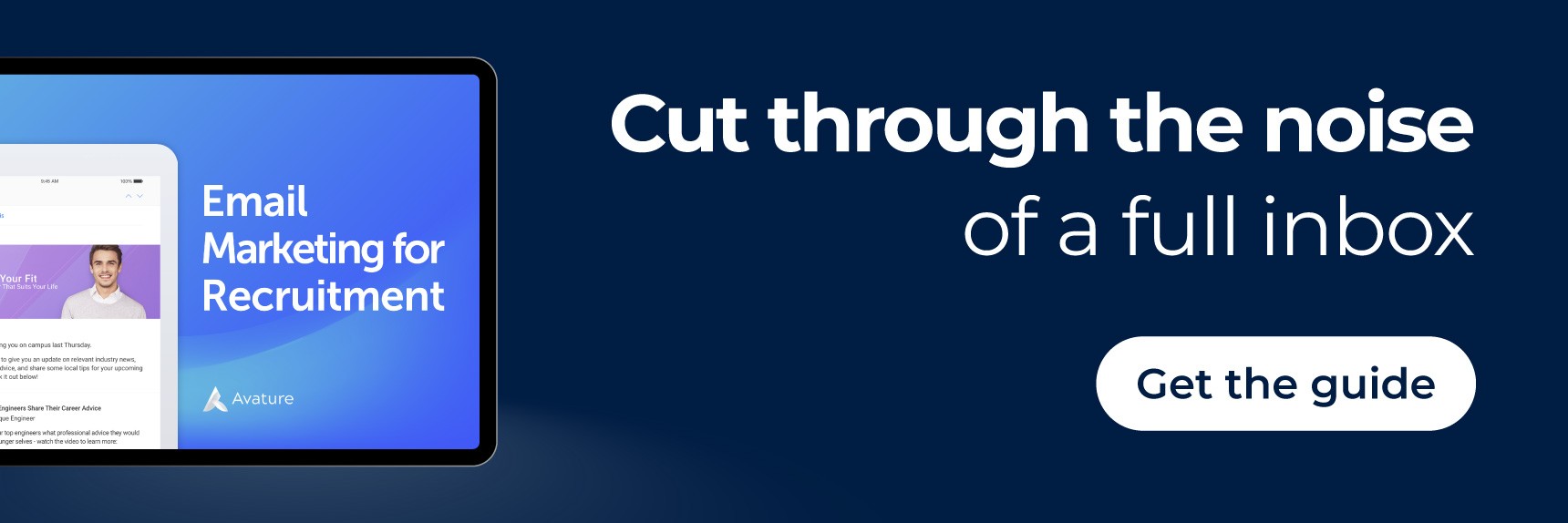Sometimes recruitment email marketing can feel like a lottery.
You spend hours drafting the perfect email, hit send and then…nothing. Tumbleweed and zero response from your audience. But it doesn’t have to be this way. Studies show that when done right, email marketing is 40 times more effective than Facebook and Twitter combined. So how can you leverage candidate marketing emails to improve talent engagement?
In a recent webinar with Lockheed Martin, Talent Engagement Strategist Marvin Smith explained that prompting an emotional response was the secret sauce of their recruitment marketing campaigns. This makes sense and is supported by a wealth of studies that demonstrate that we make instinctive decisions much more quickly than we take considered actions.
The Importance of Timing in Recruitment Marketing
Your first opportunity to trigger a gut response comes before you even put pen to paper.
Lockheed Martin starts by identifying when prospects would be most receptive to a career change. This could coincide with a birthday, a work anniversary, or it could happen at times of career stagnation – all of which can be easily established and scheduled with Avature CRM.
They then craft tailored messaging that will resonate at these specific times. For example, one of their recent recruitment marketing campaigns targeted individuals when their company was undergoing change, with messaging specifically tapping into the accompanying uncertainty.
The success of this type of talent engagement strategy hinges on the integrity of your leads. This is especially true considering that talent databases can degrade by as much as 22.5 percent per year, making it paramount that you keep your information clean and up-to-date.
With Avature CRM, you can minimize this risk by creating an email that is automatically sent to every person that has created a profile through your talent community, in which you can ask prospects for updates on contact information, job experience and skills and points of interest. Recipients are then empowered to provide these updates through the talent community portal. Not only can you configure the frequency, branding and substance of your communications, but you have the opportunity to keep candidates warm and your database up-to-date in one go.
Engage Candidates With Catchy Email Subject Lines
The subject line might seem like an afterthought to most people. It’s just a handful of characters, right? But these few words are your biggest weapon in the battle of the inbox, where recipients make an almost subconscious, split-second decision on whether they’ll open your email.
By using catchy email subject lines such as “Surprised by the success of others?”, Lockheed Martin harnesses powerful motivating factors such as FOMO (Fear Of Missing Out) to instinctively engage candidates at first glance. Another of their recent recruitment email campaigns centered on the concept that “we all have a career story,” in which they provoke a cocktail of emotional responses (such as aspiration and curiosity) with subject lines that include “If your career was a book, how would you title it?”
At this point, keep in mind that your subject lines should be short and snappy. Studies show a peak in open rates for 41-character subject lines, with interest tailing off for those that exceed eight words.
While it might sound tough to cram an emotional punch into such a tight space, remember your recruitment emails could be packed with longer, Pulitzer-worthy prose, but if it’s not opened, it’ll be lost to the abyss.
Finish Your Recruitment Emails With a Call to Action
Your talent engagement strategy will likely have a measurable end goal..
This could be introducing your company to candidates with a career conversation or encouraging them to register for your talent network. This is why a strong call to action is a must-have, as it ensures that engaged prospects aren’t left in limbo when they reach the end of your communication. Instead, they should be inspired to take the all-important next step, whatever it is.
As we have seen, stimulating the lizard brain lies at the heart of any fruitful recruitment email, and the call to action is your final opportunity to do so. You can do this in any number of ways, from suggesting scarcity of opportunities to creating a sense of urgency.
Track and Test Your Recruitment Emails
You’d be forgiven if you thought that once you’ve hit send, you can sit back and watch the clicks roll in.
Well, it’s crucial that you seize this chance to monitor the performance of your candidate emails to measure performance and engagement. All of this can be achieved with Avature CRM, which will empower you with a variety of in-depth metrics to enable you to strategize for the future.
The talent stakeholders at Lockheed Martin were able to easily ascertain that their most successful talent engagement campaign was the one centered on FOMO, which garnered a 90 percent open rate and initiated 13 candidate interviews. These figures helped them to forecast and mold future recruitment marketing campaigns.
Note, that as with any other form of marketing, recruitment marketing also requires that you be able to adapt to changes in preferences in your target demographic.
Avature’s reporting capabilities will give you up-to-date data on your campaigns, which will allow you to assess their performance and continue taking the best course of action to reach your company’s recruitment goals. With a team of talent stakeholders that act fast and make data-driven decisions, you’ll be better equipped to continue tailoring your messages to your audience’s taste while boosting conversions.
Final Thoughts on Recruitment Email Marketing
We can all think of times when we were stopped mid-scroll by an ad that piqued our curiosity, or were compelled to act by a subliminal sense of urgency. This is why it is so important that your recruitment emails make a great impression on your target audience. With Avature, you can test, track and convert top candidates with ease.



